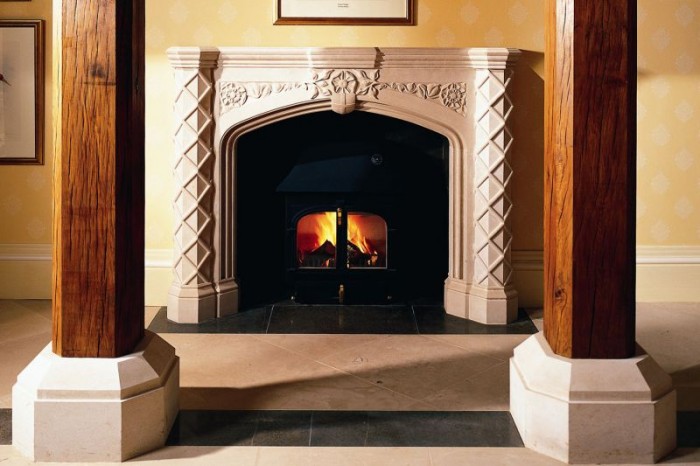The range of natural stone materials at the disposal of interior designers and architects is staggering. It’s hard enough learning the different architectural properties of the main stone types on offer (i.e. granite, marble, limestone) without getting into the various families of each stone type (i.e. black granite versus red granite, or Portland limestone versus Ancaster limestone), let alone the variants within each family (i.e. Portland Roach, Portland Whitbed and Portland Basebed)!
And it doesn’t end there either. Depending on the lighting chosen to accent your stone features, drastically varying effects can be achieved. Considerations for lighting natural stone might include:
- Natural light or artificial light
- Incandescent lights, LEDs or traditional light bulbs
- ‘White’ light or coloured light
- Uplights or downlights
- Ambient, focal or feature lighting
- Daytime versus night-time lighting
“Light, God’s eldest daughter, is a principal beauty in a building.”
— Thomas Fuller
Daytime lighting
You could be forgiven for assuming that ‘daylight’ in all places is the same… but in fact the intensity of natural light can vary quite dramatically from place to place. Days have different lengths at different latitudes, plus different areas can be affected by different levels of shade and reflected light (i.e. different altitudes or even different sides of the same building). Both architecture and interior design must lend themselves to these subtle variances.
“The English light is so very subtle, so very soft and misty, that architecture has responded with great delicacy of detail.”
— Stephen Gardiner
There are a couple of ‘rules of thumb’ for lighting natural stone in the daytime. Firstly, let’s state the obvious; your best options are windows and skylights. With a little forethought, you can still achieve focal, feature or ambient effects with either.
- Focal = narrower beams of light to accentuate a very specific area or item in a room. Smaller, strategically placed skylights are best for this effect.
- Feature = highlighting an architectural feature, such as a wall, fireplace, staircase or an interesting texture. Skylights, roof windows and smaller wall windows can all be used.
- Ambient = light which illuminates a wide area of a room, generally making the whole room brighter i.e. usually from a conventional window or large skylight.
Obviously the angle of the sun must be considered carefully. But the real skill lies in knowing what to do with those areas where natural light doesn’t reach: Should you accent them with artificial lights or leave them slightly darker?

In the image above, the area beneath the staircase is spot-lit creating an ‘airy’ space in a large room—despite the large window (off to the left of the image) not letting huge amounts of light into that space. In the image below however, the area underneath the staircase and balcony is left darker, creating a more secluded ‘nook’ away from the rest of the open space—despite the large window letting in lots of light.

“Residences offer almost immediate gratification. You can shape space, light, and materials to a degree that you sometimes can’t in larger projects.”
— Steven Holl
lighting natural stone: Downlights v Spotlights
Downlighting
Generally, lights which point down create personal, secluded areas. Attention is held in the glowing pool of light cast downward, making this a great choice for dining areas. Many public service areas in larger buildings also use downlighting to create more intimate spaces for visitors to talk to staff.
Downlights are most often used for accenting features where the intended effect is delicate and understated; for example a polished dining room table may be too reflective for spotlights, but could still look great with downlighting.

While downlighting is not always the best means of highlighting textures on highly ‘finished’ vertical surfaces, it can be great to accent uneven faces where subtle irregularities can be highlighted or cast long shadows (as you can see with the Ian Knapper Portland stone fireplace above).
Spotlights
Downlights always point, well, down. Spotlights on the other hand can point anywhere. They generally emit more intense light but do so in a more focussed area. Well thought-out spotlighting can be an excellent means of drawing out the character in natural stone; whether that character is its homogeneity or granularity, its subtle hues or its imposing presence.

Limestone often has a very subtle character and can benefit from spotlight illumination. On the other end of the spectrum, polished black granite displays a much more vibrant sheen and a deeper ‘sparkle’ when spotlight; making it a very popular choice for bathroom interiors.
Ambient Light
Even ambient light can be used to create amazing effects with the right textures and geometry in the room. The Ian Knapper fireplace below is a great example. The key with ambient light is utilising bold patterns and designs (particularly regular patterns) where the light can play on larger scale geometric features. Note how both the stone fireplace surround and the wooden beams show a range of deep hues purely due to the light and shadow playing on the well-defined shapes.

“Architecture is the learned game, correct and magnificent, of forms assembled in the light.”
— Le Corbusier
Talk to us about interior design ideas and solutions for lighting natural stone. Call us TODAY on 01538 722 733 or email us.

